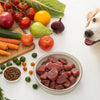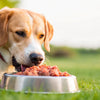How to Store Raw Dog Food: A Comprehensive Guide for Pet Owners
- Houndsy
Table of Contents
- Introduction
- Understanding Raw Dog Food
- Best Practices for Storing Raw Dog Food
- Tips for Managing Raw Dog Food
- The Role of the Houndsy Kibble Dispenser in Feeding Routines
- Conclusion
Introduction
Did you know that nearly 60% of dog owners are opting for a raw food diet for their furry friends? This rising trend indicates a growing awareness of the benefits of feeding dogs a diet that closely mimics their ancestral roots. While the idea of feeding our pets raw food can be appealing, it comes with unique challenges, particularly in terms of storage. How do we ensure that our raw dog food remains fresh, safe, and nutritious?
In this blog post, we will delve into the essentials of how to store raw dog food, exploring the best practices to keep your pet’s meals safe and healthy. We’ll provide a comprehensive understanding of different types of raw dog food, optimal storage conditions, and practical tips that make handling raw meals manageable and effective. By the end of this post, our goal is for you to feel equipped and confident about safely storing your dog's meals while enhancing their feeding experience.
Let’s embark on this enriching journey together, reflecting on our own pet feeding routines and understanding how we can elevate them with proper storage techniques.
Understanding Raw Dog Food
What is Raw Dog Food?
Raw dog food encompasses a variety of diets that include uncooked meat, bones, fruits, and vegetables. It’s believed that such diets can provide numerous health benefits including shinier coats, healthier skin, and improved digestion.
Types of Raw Dog Food
- Frozen Raw Dog Food: Often sold in packets and requires storage in a freezer until ready to serve.
- Freeze-Dried Raw Dog Food: Typically more shelf-stable but should be kept in a cool, dry place, resealed in its original packaging.
Understanding the differences between these two categories is crucial as they dictate different storage methods.
The Rise of Raw Dog Food
As pet owners become more conscious of their pets' diets, raw feeding is gaining popularity. This trend aligns with the increasing interest in natural and holistic pet care methods. By feeding our pets a raw diet, we aim to provide them with nutrient-rich food that resembles what they might consume in the wild.
Best Practices for Storing Raw Dog Food
Storing Frozen Raw Dog Food
For frozen raw dog food, the key lies in temperature control and minimizing the risk of bacteria growth.
1. Keep It Frozen
To ensure safety, always store frozen raw dog food in the freezer until you are ready to use it.
- Temperature Control: Bacteria can thrive when food is stored at temperatures above 8 degrees Celsius (46.5 degrees Fahrenheit), which is why all raw dog food should remain frozen until needed.
2. Packaging
It’s best to keep raw dog food in its original packaging. This ensures the product remains vacuum-sealed and fresh, minimizing exposure to air and potential contaminants.
- Use Airtight Containers: If re-packaging is necessary, ensure you use airtight containers designed for freezer storage to avoid freezer burn.
3. Ideal Freezer Organization
To maximize space and accessibility, organize your freezer strategically:
- Stackable Containers: Consider using stackable containers or bags to make the most of your vertical space.
- Label Your Food: Clearly label each package with feeding dates to keep track of freshness.
Thawing Process for Raw Dog Food
When you are ready to serve, a proper thawing method is essential to maintain safety and nutrition.
1. Refrigerator Thawing
- Plan Ahead: The safest method for thawing frozen dog food is to transfer it to the refrigerator for 24-48 hours prior to meal time. This slow thaw helps retain the integrity of the food.
2. Quick Thawing
If you’re in a rush:
- Cold Water Method: Submerge the sealed package in a sink filled with cold water, changing the water as needed. Avoid using a microwave to thaw raw food, as this can heat unevenly, potentially creating unsafe temperatures.
Storing Defrosted Raw Dog Food
Once you've thawed the food, proper storage within the refrigerator also requires careful consideration to maintain safety while serving.
-
Keep It Cool: Once opened, defrosted raw dog food can be stored in the refrigerator for 4-5 days. Ensure it remains at a consistent temperature below 4 degrees Celsius (39.2 degrees Fahrenheit).
-
Separate Storage: Designate a specific area in your refrigerator solely for your pet's food. This helps in minimizing cross-contamination with other foods.
Long-Term Storage Solutions for Raw Dog Food
In some cases, having a dedicated bin or freezer for dog food can simplify the process of raw feeding:
-
Dedicated Freezer: If you often purchase frozen food in bulk or prepare homemade raw meals, consider a separate freezer for storage. These can be placed in a utility room or garage, provided they are kept at suitable temperatures.
-
Portioning Ahead of Time: For the meal preppers out there, consider portioning raw food into daily servings before freezing. This not only saves time during meal preparation but also ensures proper reserved portions remain frozen until use.
Tips for Managing Raw Dog Food
Handling raw dog food doesn't have to be daunting. Here are some simple tips to make the process smoother and safer:
Hygiene Practices
-
Clean Utensils: Always use clean utensils, preferably stainless steel, to serve your pet. This minimizes the risk of contamination.
-
Surface Safety: Ensure that surfaces used to handle raw food are sanitized. A quick wash with hot soapy water is usually adequate.
Serving Ideas
- Use Designated Bowls: Although your dog may love anything you serve, consider using designated feeding dishes that are easy to clean and can’t be knocked over.
Monitoring Freshness
-
Check Dates: Regularly check the expiration dates on raw food packaging, especially since they can vary by brand and type of ingredients.
-
Smell Test: Always inspect raw food for any off smells or discoloration, which can indicate spoilage. When in doubt, throw it out.
The Role of the Houndsy Kibble Dispenser in Feeding Routines
At Houndsy, we understand that elevating the pet feeding experience requires thoughtful design paired with functionality. Our flagship Houndsy Kibble Dispenser is tailored for all aspects of dog feeding, including those who may be transitioning to or incorporating raw food.
Designed for Convenience
The Houndsy Kibble Dispenser features a convenient crank that allows for portion control from a standing height, eliminating the need for awkward bending or lifting. This is particularly beneficial for pet owners who handle raw dog food, ensuring that the feeding experience remains efficient and enjoyable.
Complementing Modern Home Decor
Our dispenser combines mid-century modern design with high-quality materials. Not only does it ensure consistent servings for your pet, but it also complements beautiful home decor.
To explore the practical benefits for your feeding routine, we invite you to check out the Houndsy Kibble Dispenser.
Conclusion
Storing raw dog food doesn’t have to be complicated. By following outlined best practices, you can ensure that your dog's diet is as healthy and safe as possible, while still enjoying the perks of raw feeding. Emphasizing the importance of cleanliness, temperature control, and organization will significantly enhance your feeding routine, allowing you to focus more on enjoying time with your furry friend rather than worrying about food safety.
As responsible pet owners, we owe it to our dogs to provide them with nutritious meals while also managing the logistics of feeding them raw. Consider implementing some of the tips discussed in this guide, and don’t forget to take a look at the Houndsy Kibble Dispenser for a chic, efficient, and convenient way to elevate your pet’s feeding experience.
FAQ
Q: How long can I store frozen raw dog food?
A: Frozen raw dog food can be safely stored in your freezer indefinitely. However, it is best consumed within 3-6 months for optimal freshness and quality.
Q: Can I refreeze defrosted raw dog food?
A: Yes, defrosted raw dog food can be portioned and refrozen. Just ensure that it has remained refrigerated during the thawing process and that it is consumed within 4-5 days after thawing.
Q: What should I do if I notice an off smell in the raw dog food?
A: If you detect any unusual odor, it's best to err on the side of caution and dispose of the food. Safety should always come first.
Q: What’s the best way to handle raw dog food safely?
A: Always wash your hands before and after handling raw food, use clean utensils, and sanitize involved surfaces regularly to prevent cross-contamination.
Q: Does the Houndsy Kibble Dispenser work with raw dog food?
A: Yes! While it is primarily designed for kibble, it can also accommodate dry raw food methods like freeze-dried meals, adding versatility to your feeding routine.












